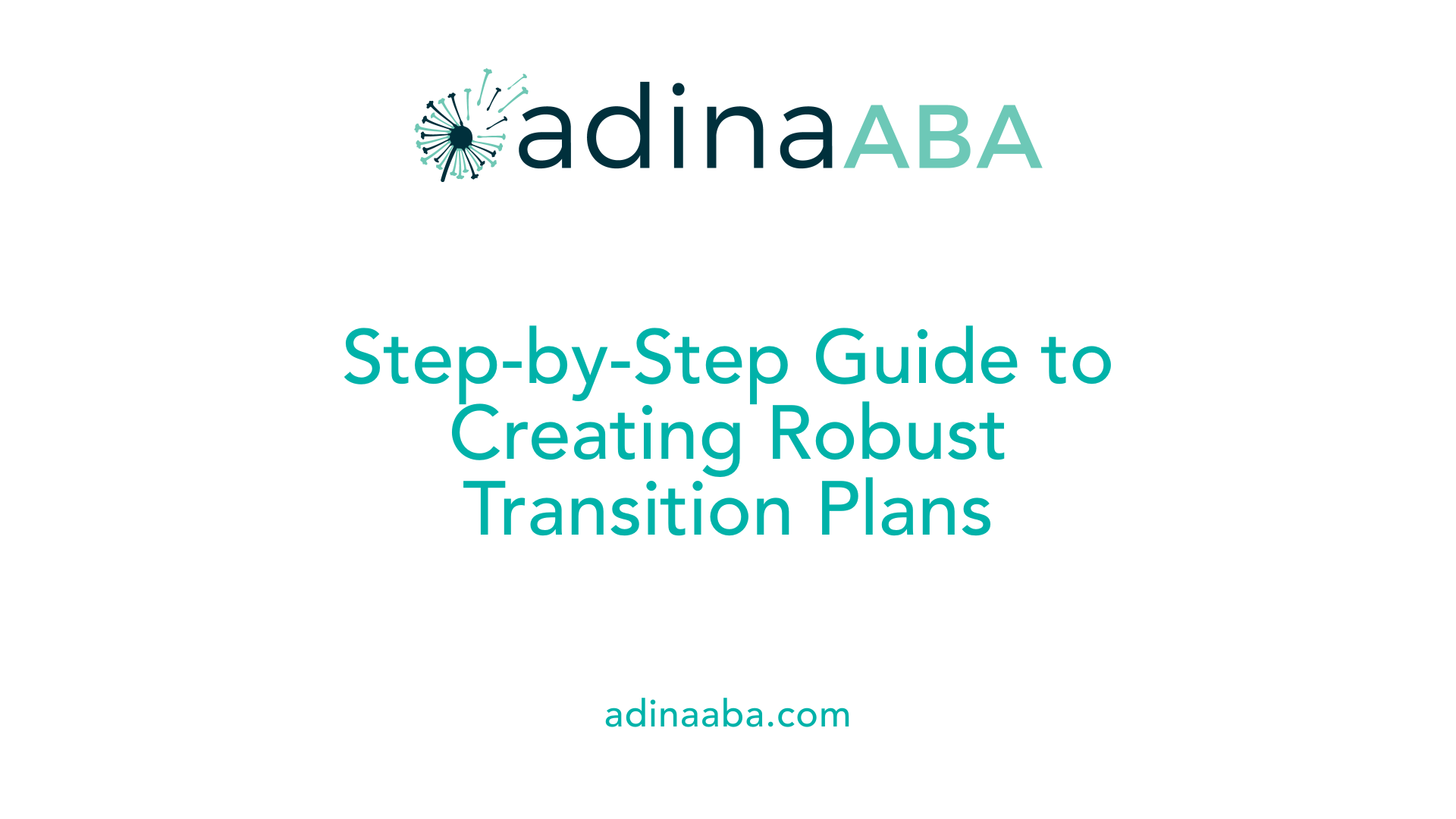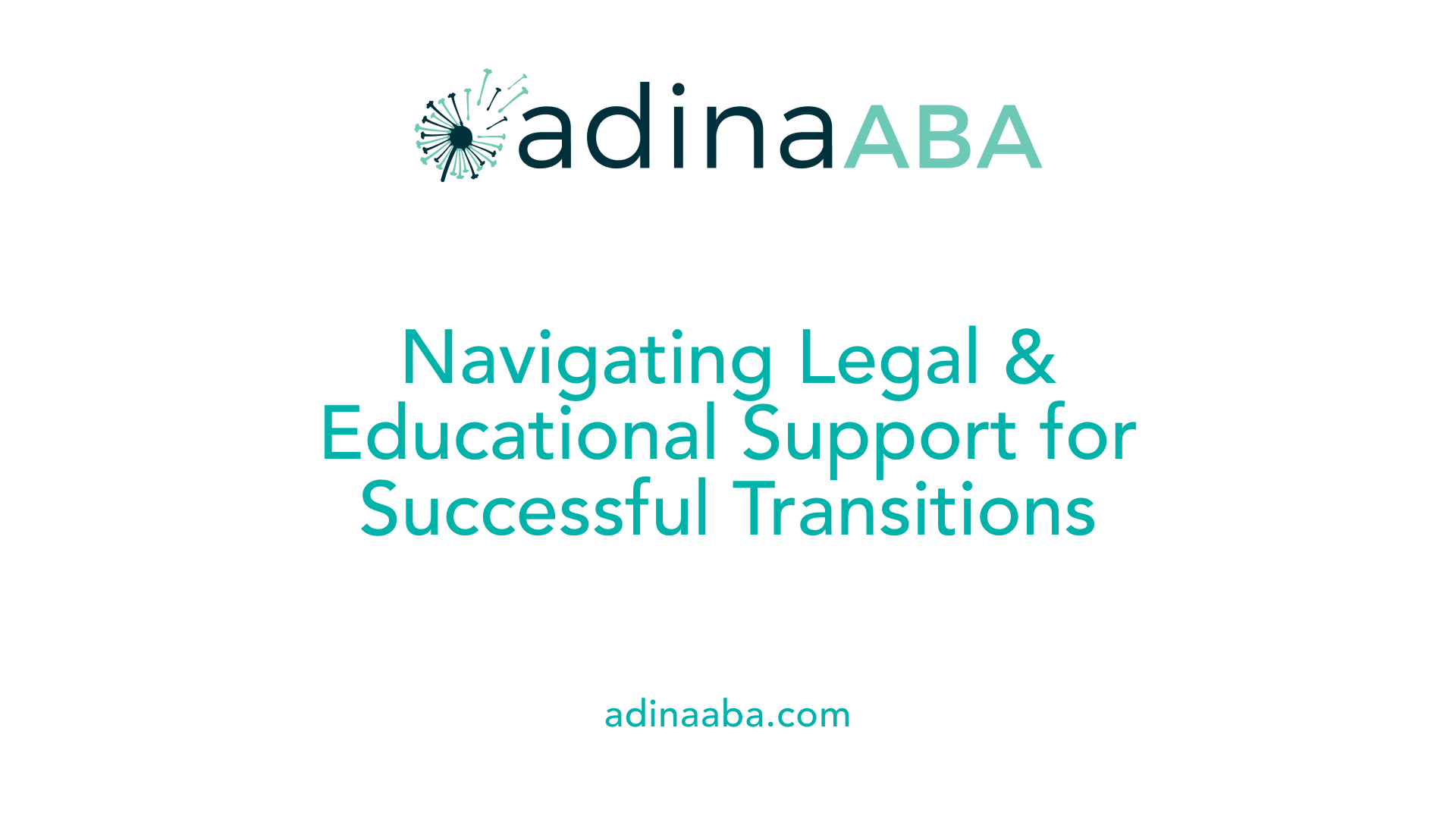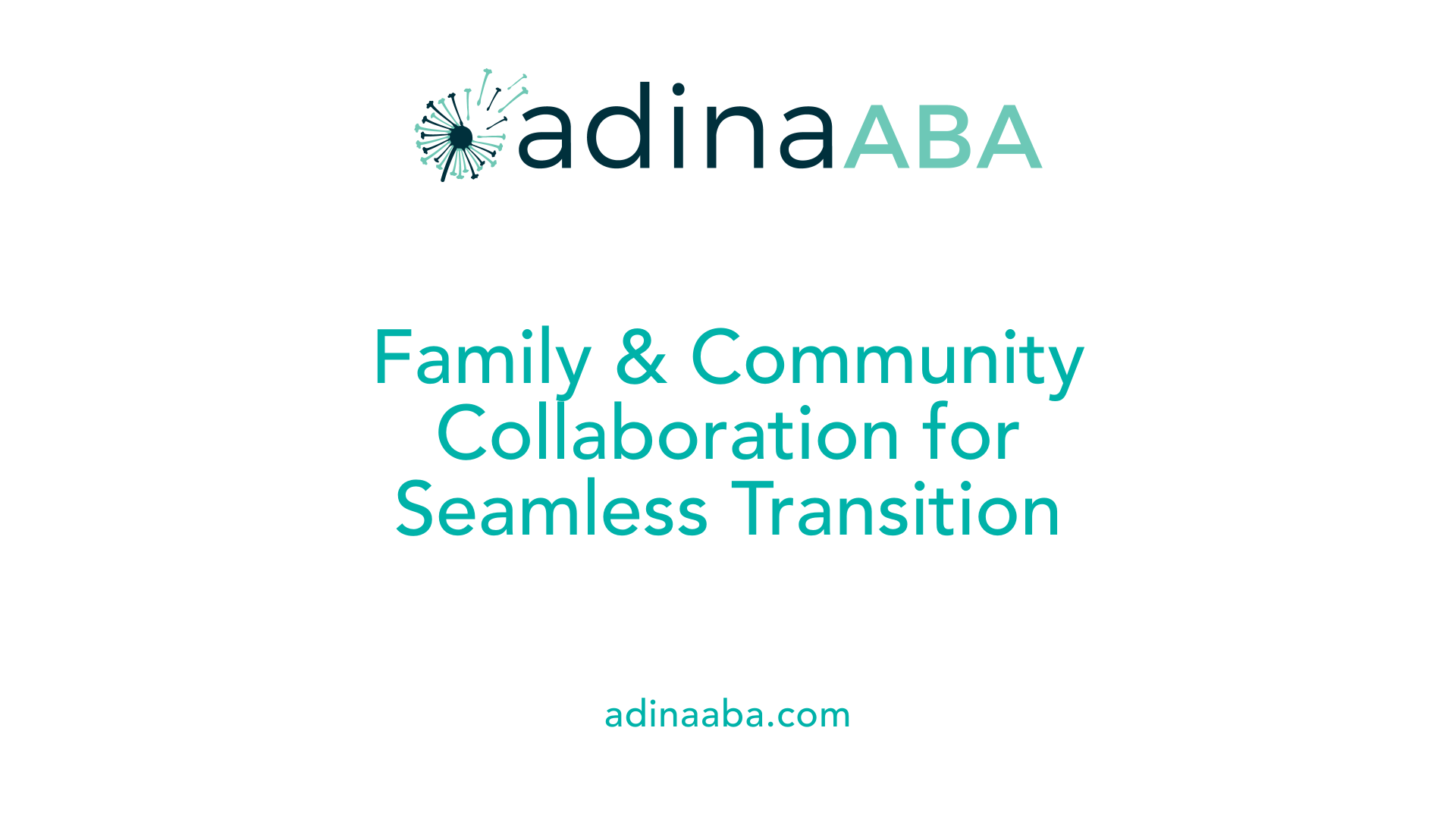Creating transition plans for older teens in ABA

Understanding the Critical Role of Transition Planning in Adolescent ABA
Transition planning for older teens with autism in Applied Behavior Analysis (ABA) is a vital process that ensures successful movement from school-based services to adult life. This process encompasses developing tailored goals related to independence, employment, and community participation, all grounded in early, continuous, and collaborative planning. The importance of structuring this transition early—ideally starting around age 12 to 14—cannot be overstated, as it equips teens with the necessary skills and supports to navigate adulthood confidently.
Step-by-step Framework for Developing Transition Plans

How do you identify transition goals aligned with student interests?
The first step in creating effective transition plans is to determine clear, personalized goals that reflect the student’s interests, strengths, and future aspirations. This involves engaging the student in discussions about their passions, preferred activities, and desired outcomes after high school. Family members, educators, and support teams collaborate to gather insights into the student’s preferences, which then shape realistic and motivating goals.
How can transition goals be embedded into IEP and ILP?
Once identified, these goals should be integrated into the student’s Individualized Education Program (IEP) and Individual Learning Plan (ILP). This ensures that academic coursework, vocational training, and social skills development are aligned with future objectives. The IEP team, including family and educators, creates specific, measurable targets linked directly to post-school ambitions, laying out a clear pathway for skill development.
Why is regular review and adjustment important?
Transition plans require ongoing monitoring to stay relevant and effective. Regular reviews—at least annually—allow teams to assess progress, address challenges, and modify goals as needed. This dynamic approach helps accommodate the student’s evolving interests, developmental progress, or new opportunities, thereby increasing the likelihood of successful transition outcomes.
What are practical skill opportunities for community involvement and self-advocacy?
Providing real-world experiences is critical. Practical opportunities include community-based activities, internships, job shadowing, and self-advocacy training. These experiences teach essential skills like communication, workplace behavior, financial literacy, and self-determination. Incorporating role-playing, community outings, and peer interactions helps students apply what they learn.
How can families, support networks, and school counselors be involved?
Family members, caregivers, school counselors, and community organizations should work collaboratively throughout the process. Regular communication, shared goal-setting, and advocacy help ensure essential continuity and support. Families can participate in workshops, support groups, and planning meetings to stay informed and actively contribute. This team-based approach promotes a seamless transition, fostering independence and confidence for the student.
Adapting ABA for Teen Independence and Life Skills Development
How can ABA help older teens develop independence and life skills?
ABA therapy plays a vital role in supporting older teens with autism to gain independence and essential life skills. It focuses on teaching practical abilities such as personal care routines, cooking, managing money, and navigating technology independently. By breaking down complex tasks into manageable steps, therapists use techniques like task analysis to make learning gradual and attainable.
Visual supports, including schedules and social stories, help teens understand daily routines and expectations. Video modeling allows teens to observe and imitate successful behaviors, reinforcing learning through visual examples. Self-management techniques empower teens to monitor their own actions, fostering autonomy and confidence.
Real-life scenarios are integrated into therapy to help teens practice skills in contexts that mimic everyday life. For example, simulated shopping trips or cooking sessions prepare them for similar real-world activities.
Family involvement is crucial in this process. Parents and caregivers reinforce skills at home and in community settings, ensuring consistency and generalization of learned behaviors across different environments.
Targeted interventions also focus on improving social skills and emotional regulation, which are essential for navigating relationships and managing puberty-related challenges.
Overall, ABA adapts its methods to meet the developmental needs of older teens, encouraging independence, social participation, and emotional resilience. This approach prepares them for a successful transition into adulthood.
Strategies for Effective Transition in ABA Therapy

What are some best practices and strategies for creating transition plans in ABA therapy?
Creating smooth and effective transition plans in ABA therapy involves several proactive strategies designed to reduce anxiety and increase cooperation among adolescents with autism. Establishing consistent routines and schedules helps create a predictable environment, making changes less intimidating and more manageable.
Priming techniques also play an essential role in preparing teens for upcoming activities or shifts. Visual aids, verbal cues, modeling, and role-playing are effective methods to familiarize the individual with what to expect, boosting confidence and engagement.
Using behavioral momentum involves starting with high-probability requests—those the teen is likely to comply with—to build positive momentum toward completing less preferred tasks or transitions. This strategy helps reduce resistance and promotes a cooperative attitude.
Visual timers and countdowns provide a tangible way for teens to understand how long a transition will last, helping them manage their expectations and decrease anxiety about change. These tools foster a sense of control and patience.
Finally, maintaining consistency across different environments—such as home, school, and community settings—ensures that skills and routines are reinforced uniformly, leading to more reliable and stress-free transitions.
Implementing these strategies with personal adjustments for each individual fosters a smoother transition process, enabling teens to adapt more comfortably to their daily changes and growth toward independence.
Teaching Emotional Regulation and Coping in ABA
How does ABA teach emotional regulation and coping skills to older teens with autism?
ABA therapy employs a range of techniques tailored to the developmental needs of adolescents. A fundamental component involves helping teens identify their emotional triggers and recognize their responses. This process allows them to understand what causes certain feelings and behaviors, paving the way for more effective management.
Positive reinforcement plays a crucial role. When teens successfully use healthy coping strategies, such as deep breathing or asking for support, these behaviors are reinforced to encourage ongoing use. Visual supports like visual schedules, emotion cards, and social stories are used to practice different emotional responses and handle transitional situations more smoothly.
Role-playing activities provide a hands-on method to simulate real-life scenarios, helping teens rehearse appropriate reactions and build confidence in managing emotions.
Functional behavior assessments (FBAs) are also utilized to understand the context of emotional outbursts. By analyzing antecedents and consequences, therapists can develop targeted behavior intervention plans that address the root causes of challenging emotions.
Family involvement is vital in maintaining progress. Caregiver training helps parents and guardians support their teens by applying strategies at home and in community settings. Consistent reinforcement across environments increases the likelihood of generalizing emotional regulation skills, ultimately fostering greater independence and emotional well-being.
Legal and Educational Frameworks for Transition Planning

What are the legal considerations and resources relevant to transition planning for autistic teens?
Transition planning for autistic teens is guided by federal and state laws designed to promote a smooth move from school-based services to adulthood. The most influential federal law is the Individuals with Disabilities Education Act (IDEA), which requires that students, starting no later than age 16, have a comprehensive and individualized transition plan incorporated into their IEPs. These plans focus on preparing teens for postsecondary education, employment, and independent living.
Many states extend these requirements to start transition planning earlier, often at age 14, recognizing the importance of early preparation. For example, New York and New Jersey mandate beginning transition discussions by age 14 or earlier.
Once students graduate or age out of the school system, federal funding through IDEA typically ceases. However, support services can continue via post-school programs like vocational rehabilitation and community agencies, which provide funding and resources for employment, training, and community involvement.
Family and caregiver advocacy play a crucial role. They are essential in ensuring that transition planning is thorough, personalized, and aligns with each teen’s strengths and future goals. Engaging with school teams and outside organizations helps develop real-world skills and secure necessary services.
In summary, understanding legal mandates and available resources allows families and educators to advocate effectively for comprehensive transition planning, ultimately supporting autistic teens in achieving independence and fulfilling adult lives.
Collaborative Approaches and Family Engagement in Transition Planning

How can families support the transition planning process for teens with autism?
Family involvement is a cornerstone of successful transition planning for adolescents with autism. Parents and caregivers play an active role by engaging in goal-setting activities that align with their teen’s aspirations and strengths. Collaborating closely with school teams, therapists, and community resources ensures that the transition plan is comprehensive and tailored to the individual.
Advocacy is crucial; families must ensure that their teen’s preferences, needs, and abilities are prioritized within the plan. This may involve attending meetings, asking questions, and seeking additional services or accommodations. Encouraging teens to participate in decision-making fosters a sense of ownership and helps develop their self-advocacy skills, preparing them for independent life.
An interdisciplinary team approach enhances the quality of transition planning. This team can include educators, therapists, vocational specialists, and community representatives working together to create coordinated support strategies. Effective communication among all parties ensures consistency and reinforcement of skills.
Ongoing dialogue and emotional support are vital throughout this process. Regular meetings, updates, and encouragement help teens face transition challenges confidently. Family engagement, when combined with professional support and collaboration, greatly improves outcomes, nurturing independence and readiness for post-school life.
| Aspect of Transition | Role of Families | Additional Support Strategies |
|---|---|---|
| Goal Setting | Active participation in defining goals | Use of shared decision-making tools |
| Advocacy | Ensuring preferences are considered | Connecting with support organizations |
| Collaboration | Working with school and community teams | Regular meetings and updates |
| Encouragement | Providing emotional support | Building self-advocacy skills |
| Communication | Maintaining open dialogue | Staying informed about rights and resources |
Fostering a collaborative environment that involves families ensures that transition plans are personalized, realistic, and aligned with the teen’s future aspirations.
Incorporating Person-Centered Planning for Successful Transitions

What is person-centered planning and how does it benefit older teens in ABA transition plans?
Person-centered planning is an approach that actively involves the individual with autism in shaping their own future. It emphasizes understanding their interests, strengths, and preferences to create a customized transition plan. This method focuses on what the teen values and aims to achieve, making the process more engaging and meaningful for them.
By centering the teen’s voice, this planning approach fosters early development of self-advocacy and decision-making skills. It encourages independence and self-determination, which are vital for successful adulthood. When teens are involved in decisions about their education, employment, and community participation, they are more motivated and committed to their goals.
In practice, person-centered planning helps align services and supports with the teen’s unique aspirations. It promotes ownership over their future, boosting confidence and empowerment. Ultimately, this approach not only improves transition outcomes but also ensures that the process is relevant and respectful of the teen's individuality, leading to a smoother transition into adult life.
Ensuring a Successful Transition
Effective transition planning in ABA for older teens requires a multifaceted approach that integrates early preparation, skill development, legal awareness, and active family involvement. Tailoring programs to meet developmental needs while promoting independence and self-advocacy forms the foundation for successful adult outcomes. Through collaborative, person-centered strategies and evidence-based ABA techniques, families, educators, and therapists can work together to guide teens confidently into adulthood, ensuring they have the skills, resources, and support needed to thrive.
References
- Adapting ABA Therapy Strategies for Teens and Older Children
- Transition to Adulthood | Autism Speaks
- Transition Planning for Children With Autism
- Unit 14: ABA and School-Ready Teens: Transitioning to Adulthood
- ABA Therapy for Teens: Empowering Adolescents with Autism
- Adapting ABA Therapy Strategies for Teens and Older Children
- Does ABA Work for Older Children? - ASAT Online
- Therapeutic Approaches for Boosting Motor Skills in Children
More Resources
Expert Clinicians
Get started today ->






